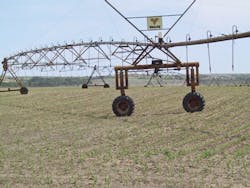Filtration: Earth's Largest Natural Filter
Water that enters the soil and flows downward likely will be used again by society. The most common scenario would be that the downward-flowing water recharges groundwater reserves that then are used as a source for drinking water or irrigation. Groundwater also often has a hydrologic connection with surface water bodies, so the characteristics of groundwater can influence aquatic habitats in a lake or river, which then may be used as a source of drinking or irrigation water. Fortunately, soil is a great water purifier—in fact, it represents the largest natural filter on the planet. The filtration benefits are an important part of the ecosystem services provided by soil.
Water Sources
When we think of water entering the soil and flowing downward, we typically imagine rainwater or perhaps irrigation water of reasonable quality. Those water sources, while they may need a bit of purification, generally are fairly clean and could be used by society without much additional treatment.
Consider the numerous scenarios, however, in which lower-quality water enters the soil and needs to be purified before being used again by society. Greywater, which is wastewater from residential dwellings except that from the toilets (that wastewater is called blackwater), is a good example of water that can be applied to soil without further treatment. An industrial equivalent to greywater would be water used in food processing, such as washing fruits and vegetables or the manufacture of cheese and other dairy products.
Effluent from wastewater treatment plants often is land-applied in an effort to recycle plant nutrients and minimize less sustainable disposal options. Similarly, water from retention ponds capturing runoff from livestock facilities often is land-applied, as is the manure. Septic systems that treat greywater and blackwater from a home also utilize the ability of soil to filter water.
Surface water runoff occurs when the rate at which water is falling on a surface exceeds the rate at which that surface can absorb water. The excess water that becomes surface runoff moves downslope, and the composition is impacted by the surface itself. That surface might be soil or an impervious material like pavement or roofing. If the surface runoff goes directly to surface water, it does not benefit from interaction with soil; however, surface runoff often eventually does enter the soil downslope of where it originated, in retention ponds or rain gardens.
Filtration Methods
Water entering the soil may contain a variety of constituents that require removal prior to reuse by society or to minimize negative environmental impact. Those constituents might include sediment, pesticides, plant nutrients, salts, bacteria, viruses, heavy metals, organic chemicals (including petroleum products), pharmaceuticals and personal care products. Considering the sources of water entering the soil, it is easy to see how one or more of these constituents could be present. Soil can provide much of the filtration needed, either as part of the ubiquitous ecosystem services it provides or by design.
The ability of soil to provide this filtration is through one or more physical, chemical or biological processes that remove or degrade various constituents in water as it passes through on its way to groundwater. Physical filtration is directly analogous to passing water through a screen: The soil acts as a sieve and holds back particles that are too large to pass through. Unlike a simple screen, however, this characteristic is enhanced by the tortuous path water takes through the soil, which provides multiple opportunities to capture constituents. Sediment and even bacteria can be removed by this mechanism.
The surfaces of soil particles often are chemically reactive and provide multiple means by which contaminants in water can be adsorbed by soil particles and effectively be removed from the water by chemical processes. Many soil clay particles have a negative charge and will attract any constituents in the water that have a positive charge (e.g., some heavy metals, salts, organic chemicals and pesticides). Another mechanism is the formation of covalent bonds (sharing of electrons) that helps soil retain many organic chemicals, pesticides and some inorganic contaminants.
Soil is teeming with life—particularly a wide variety of microorganisms that have the ability to degrade or transform both organic and inorganic substances in the soil environment. This is particularly useful when water contains organic materials that have a high biological oxygen demand and would impart negative effects on water if they did not undergo further decomposition first. This would apply to effluent from wastewater treatment plants, food processing waste and water from livestock facilities. In addition, soil microorganisms can often specifically degrade organic chemicals that would be considered contaminants if present in drinking water.
Filtration Limitations
Like a filter designed and built by engineers, the ability of soil to purify water has limitations that must be recognized and taken into account. It is no coincidence that nitrates, a form of nitrogen that acts as a plant nutrient, and trichloroethylene, an organic solvent, are two contaminants that often are reported to be in groundwater if one considers the characteristics of those substances. Both are soluble in water and neither can be chemically adsorbed by soil or degraded or transformed by soil microorganisms. As a result, both essentially move with soil water and frequently end up in groundwater.
Sandy soil allows water to move quickly through and has limited ability to chemically adsorb constituents in water, thus limiting opportunities for filtration. Groundwater quality issues are more common in areas with sandy soil and where the groundwater is close to the soil surface. Any soil has a finite capacity to purify water, and excessive applications of water or other materials requiring purification to the soil can result in limited treatment.
Soil is a great water purifier. Society and the environment benefit from it, whether from the ecosystem services it provides that protect freshwater resources, or from its deliberate use as a filter, which allows us to effectively remove a variety of byproducts with relative ease.
Download: Here


